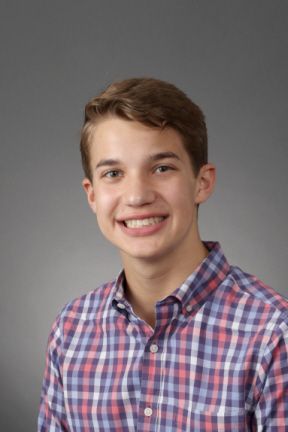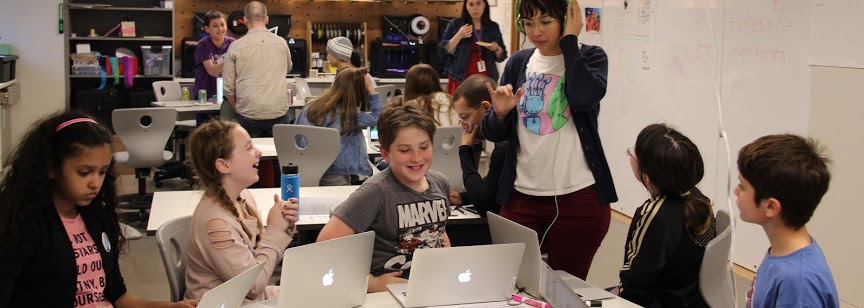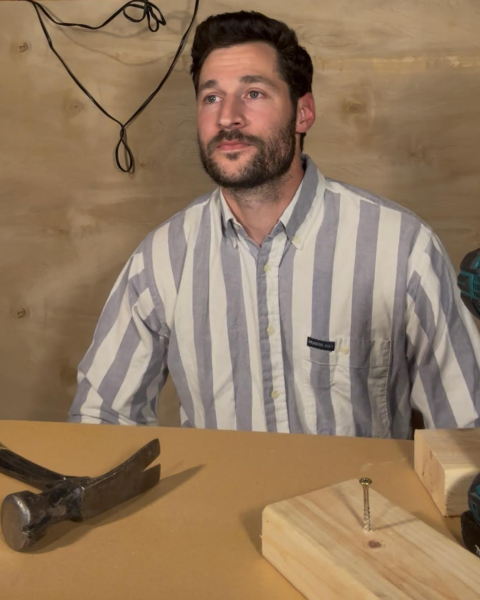Let’s Get Technical
Parker Hosts First Annual Hackathon
Hackathon participants play with CoSpaces Edu, an educational technology. Photo courtesy of Adam Colestock.
A fifth grader is attempting to type code into a laptop and also keep up a conversation with his teammates about what the virtual room he is designing should look like. After a brief moment, he places the computer on the table, and shows his group members of his work.
Around him, the walls of the TIDES garage—normally painted a bright white—are coated in drawings of buildings, bird’s-eye views of hallways, and plans for creation. The tables, covered in Expo marker scribblings, plates of chips and fruit, half-empty cans of soda, and MacBook Air laptops running the same program of CoSpaces Edu, an intuitive educational technology, “designed to enhance 21st century learning skills.”
On Thursday, April 18, Parker hosted its very first annual Hackathon in the Kovler Library’s TIDES Garage. The official description of the Hackathon, as stated by the Parker website, is an immersive event in which participants “will be working in teams to design immersive virtual experiences for the Parker community using the modeling and coding tools available through CoSpaces Edu.”
With nothing other than a prompt to “develop an interactive CoSpaces project that would be interesting and appealing for members of the Parker community to enjoy,” a group of fifth, sixth, and seventh graders used their coding skills and natural creativity to design worlds for the Parker community to test out and experience. The participants were given five hours in total, from 3:30 p.m. to 8:30 p.m., to create a world that would capture the attention of anyone who wanted to experience it in Virtual Reality (VR).
CoSpaces Edu functions by having the programmer drag in “blocks” of code with stated directions on them. By placing them in specific sequences, the students managed to create a variety of different projects to share with others. The only parameters were the prompt that the students were given, as the rest was up to their imagination.
One example of the projects created by these participants is one in which the player appears facing a blue ocean on a boat, with instructions telling the player to “dive in and click on the circles on the ground.” Designed with a small island, jumping dolphins, and lots of animated sea creatures, the game has the player search the ocean floor to find items that they have to click on and progress through the game, all for the reward of saving a whale and visiting a secret island.
The term “Hackathon” is misleading, as no hacking is involved in the event. Rather, students were given laptops and told to design whatever they felt would be appealing to the Parker community in five hours.
“The idea of a Hackathon is one that you’ll see, kind of, in other spaces, there’s been, like, city-wide Hackathons, and tech-sponsored Hackathons, so it’s kind of a known event in the technology community,” Middle and Upper School Librarian and Information Services Specialist Annette Lesak said. “A lot of times, a Hackathon will be centered around a particular problem, which kind of made our Hackathon a little bit more, unique, in that we didn’t have an individual problem.”
The event was organized by Middle and Upper School Director of Studies Sven Carlsson, Lesak, Lower and Upper School Stem and Coding teacher Adam Colestock, and Upper School Computer Science teacher Aaron Lee.
According to Carlsson, the Hackathon’s goal was to “in line with the mission, bring kids together to, as a community of learners, create something new, like, collaborate, articulate a shared vision, and build something that hasn’t been built before, but that requires different people with different perspectives working together to create a shared vision.”
Additionally, Carlsson felt that the idea of a Hackathon would be perfect for Parker and student interests at the time. “I think, also very practically, we have a lot of kids who really like coding, who really like engineering, who like building things, who like designing things,” Carlsson said, “and so because of all the great work that ILIS has done, and all the teachers do in LS and IS and MS, in particular, laying that groundwork, we wanted to give kids, sort of a form, to put those skills to the test, or I guess, run with those skills.”
ILIS, or Integrated Learning and Information Science, is the name of a new department created this year, which Lesak, Colestock, and Lee are all a part of. According to the Parker website, the curriculum that is being incorporated into many classes all around Parker “is uniquely structured to enable students to follow interests and pursue passions while making connections from concepts to the classroom to the community.”
The prompt to develop an interactive project that would be interesting for the Parker community was very in–step with Parker’s motto, according to Carlsson. “It also felt very progressive, because the prompt was open enough where students got to really direct what their product would be,” Carlsson said. “The idea, even in the prompt, is to design something for the Parker community.”
The event has been in the works for about a year, and Carlsson feels that the idea started after he transitioned from an Upper School math teacher to his current role as Upper School Director of Studies. “For me, the original appeal of it was, when I left the classroom, I was like, ‘okay, as Director of Studies, one of the things I have more time to do is to talk to my colleagues and collaborate, and something that is interesting to me personally is the intersection of math, coding, science, and general creativity, and art,” Carlsson said.
Participants in the Hackathon felt similar to Carlsson about the result of the event. “I think it’s a pretty good team building exercise,” fifth grader Ari Deutsch said, “and we get to know each other more and get to mess around, have fun ideas, lose, win, or fail forward, as you might say.”
Deutsch was not alone, as fifth grader Eli Flaum felt similarly. “It’s great for making mistakes,” Flaum said, “and building off of them and struggling to get to a goal, to achieve something and also to be really creative.”
Despite the Hackathon only being in its first year of presentation, the creators of this event are already figuring out what could have been improved. “I was saddened that we didn’t get more of a range…we got fifth, sixth, and seventh, which was great,” Carlsson said, “it would have been nice to see more representation eighth through twelfth.”
In a schoolwide email sent, the invitation was for grades fifth–twelfth, yet only fifth–seventh graders were in attendance. “I think, realizing why some kids didn’t attend, figuring out like, ‘oh, is it a structure thing, is it a different kind of design prompt, what was sort of enticing for kids,’ I think that’s a question we’ll sort of look at,” Carlsson said.
And yet, plans are already being crafted for future Hackathons to entice more Upper School participation. “I think offering more sophisticated opportunities for the high schoolers like using the 360 video cameras that we have now to kind of take footage and create virtual spaces in actual spaces, if that makes sense,” Lesak said. “In CoSpaces, kids are creating these fake worlds, so they’re in a haunted house, or they’re on a mountain top, but using a 360 camera, you can take footage of, you know, the Parker courtyard, and have that be a virtual reality space.”
However, Carlsson thinks the goal of the Hackathon was mostly achieved in those five hours in the library. “The goal, or the purpose of the Hackathon evolved, to be honest, to what the plan was going into Thursday,” Carlsson said. “The vision and the goal we were able to articulate for the Hackathon was so much better, I think, then the first prototype of the vision. I don’t think we achieved it, but I think we achieved the vision we had for Thursday this year.”
In the end, when the programs had been presented and the pizza was gone, Carlsson reflected on how he felt the event went. “I was really happy, I thought it went great. It exceeded my expectations, is the honest truth,” Carlsson said. “I was hopeful, but a bit fearful, I didn’t sleep, I woke up at like, four in the morning. I thought I was all calm and cool about it.”
Despite all of his work and planning, Carlsson thinks that there was no guarantee how the event would turn out.“I trusted the people involved, and sort of the planning, but the big question mark was really, how students would respond to it,” Carlsson said, “because you can hope to create the right environment for them to thrive and really find something interesting, but ultimately, it’s not about what we think.”
To finish out the five hour night, the participants spent thirty minutes presenting how their design ended up working in their projects to parents and faculty. “The final showcase was really cool because it brought parents together, we were all gathered together by the blue couches, and the kids sort of came up, and presented what they worked on,” Carlsson said. “It sort of blew my mind what they were able to do in four hours. It’s a lot of time, but it’s sometimes not a lot of time. But they were tremendous.”








